Please share with your friends!
Stick labels around the house for print awareness
When I was a Montessori teacher, each morning I would get a fresh piece of paper and create a sign for the snack the children were having that day and how much to take. For example, the sign would say:
Take:
1 graham cracker
1 scoop of raisins
On the sign, I would sketch a simple picture of the graham cracker and the raisins, too!
Making labels and signs for things in the classroom and around the house are excellent for print awareness for young children.
When walking into a Montessori Early Childhood classroom you’ll notice that there are print signs almost everywhere, labeling things on the shelves, different fixtures, activities, tools, and areas of the classroom.
These labels or signs, for example, the sign for snack I made for the snack table every morning, helps the children to be independent:
- The sign tells them how much snack to take
- They can get their own snack without a teacher’s help
But the sign also helps with print awareness and early literacy development for young children who are not reading yet.
In this post, I’ll share with you a naming lesson we did in the classroom. I’ll also share what happened when we named and labeled things around the house with my three-year-old daughter, Annie at home!
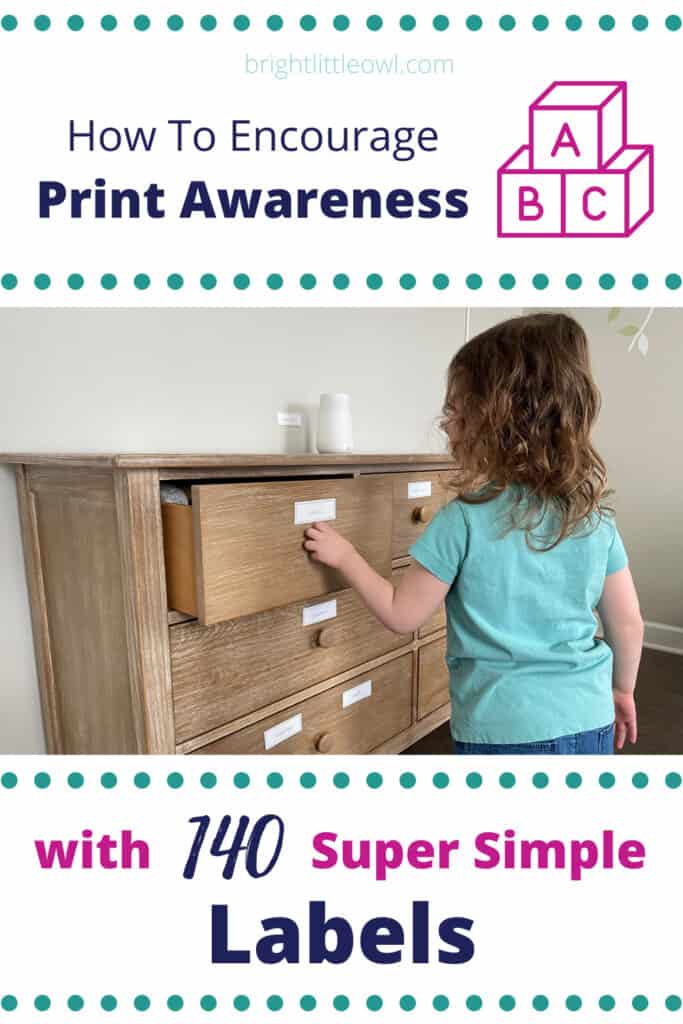
In This Post
Why is print awareness important for young children?
Reading Rockets has an excellent article with a video about print awareness in young children and why it is important.
"Print awareness (also called concepts of print) is the understanding that print carries meaning, that books contain letters and words. Print awareness also includes an understanding of what books are used for and how a book "works" — how to turn pages, how to find the top and bottom of a page, and how to identify the title and the front and back covers."
Reading Rockets
In my previous post, Create 4 Simple And Playful Storytelling For Kids Activities, I talk about your child making the connection between the printed word and the spoken word by practicing dictation.
Dictation is one example of encouraging and practicing print awareness with young children. Another example is noticing that everything has a name and also that print is all around us.
My daughter Annie is starting to notice signs as we are out and about or driving in the car. She notices stop signs and other traffic signs and asks about them. Also, while at the grocery store she notices and points out signs and pictures in the produce section. I’ve also pointed out signs listing the rules to Annie when we go to the indoor play gym.
Placing print labels or signs for fixtures and objects around the house is a fantastic way to reinforce that everything has a name and that the printed word is directly connected to the words we say.
Labels or signs for print awareness also help with:
- excitement for language and words
- vocabulary enrichment
- noticing letters and how they go with objects
- preparation for writing and reading
Additionally, labels or signs can help with:
- your child’s independence
- organizing the activities and toys on your shelves and bins
- your child remembering where an activity goes back on the shelf
The naming game
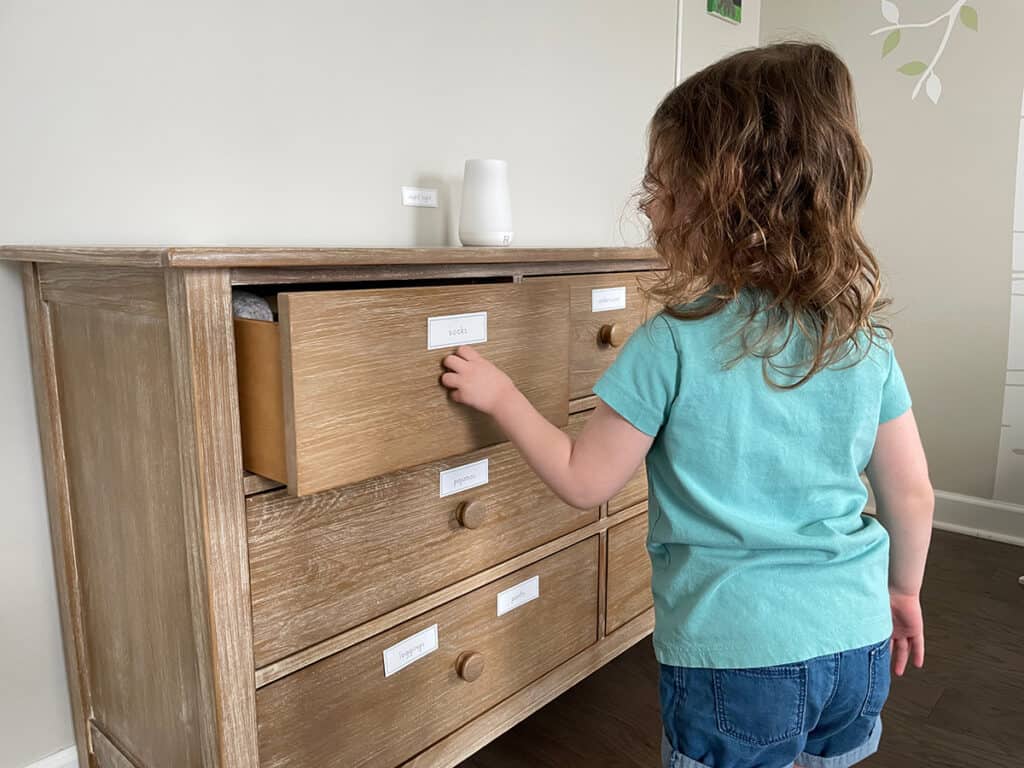
The first thing we did was play the naming game, which is simply naming objects around the house.
This is something we did in the classroom for many of the young three-year-olds. The naming game helped them to learn the names of things that were new to them in the classroom.
Your child probably already knows the names of most things all around the house. But we’re focusing on the point that everything has a name, just like you have a name.
Annie and I went around her bedroom and we touched everything and named it. Have fun with it and be silly! Name the obvious things but also pick the trickier fixtures that your child may not remember the names of yet. For example:
- chandelier
- dresser
- night light
- night stand
- headboard
- drapes
- blinds
- light switch
- outlet
The missing object game
To further explore with the naming game and to make it fun, we played the missing object game in the classroom. The children love this because it’s fun and silly at times. It grabs their attention.
I tried this with Annie and she was tickled pink with this game!
- I asked Annie to find three objects from around the room that we can put on this mat (or you can use a towel). She chose scissors, a tray and a dog figure. She has really been into dogs lately.
- Then we covered the three objects with the mat.
- I asked Annie to close her eyes while I take a way one object and hide it. No peeking!
- I asked Annie to open her eyes.
- I lifted up the mat to see the two objects left. Which one was missing? Annie guessed right! The scissors were missing.
- She wanted to keep covering the objects with the mat and lifting it up again. This was the best part!
We kept playing this game. You can also give your child a turn to take something away and hide it for you to guess!
140 labels around the house
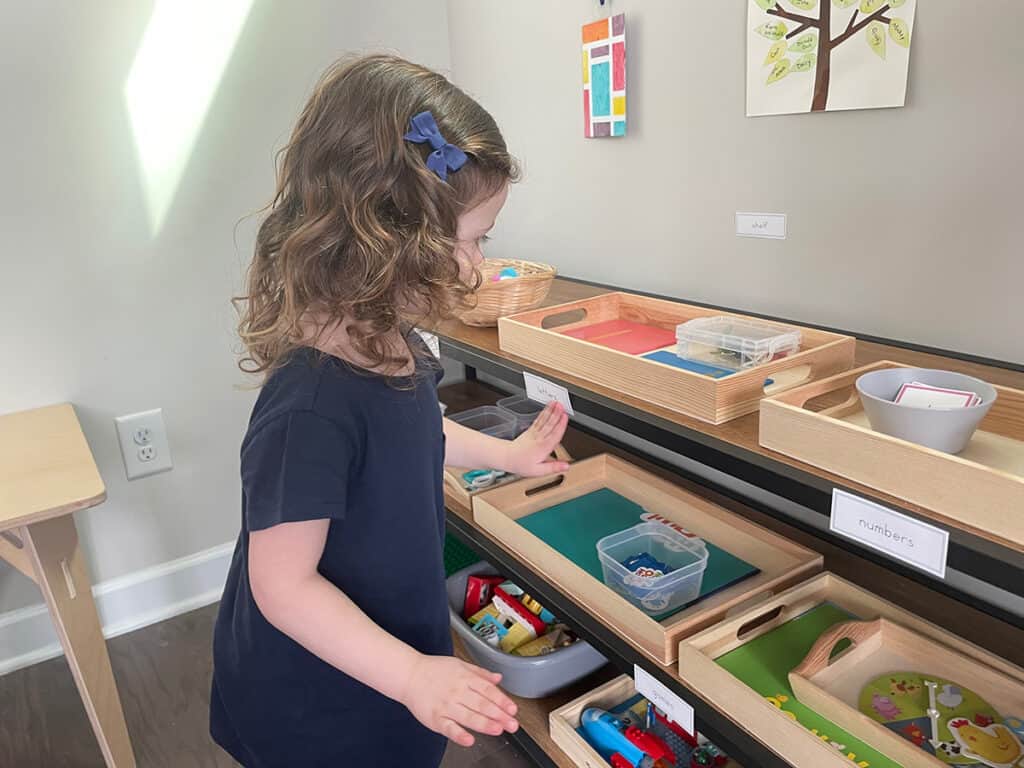
I created 140 labels for objects and fixtures found around the house, including the bedroom, bathroom, her activity and toy shelf, the kitchen and living room.
*Note: If you’d like to download the 140 labels around the house I created, scroll down to the bottom of this post and sign up for the Resources Library.
If you don’t want labels all over your house, you could just choose a few and put them only in your child’s room and/or play area. Start with the places that your child spends the most time.
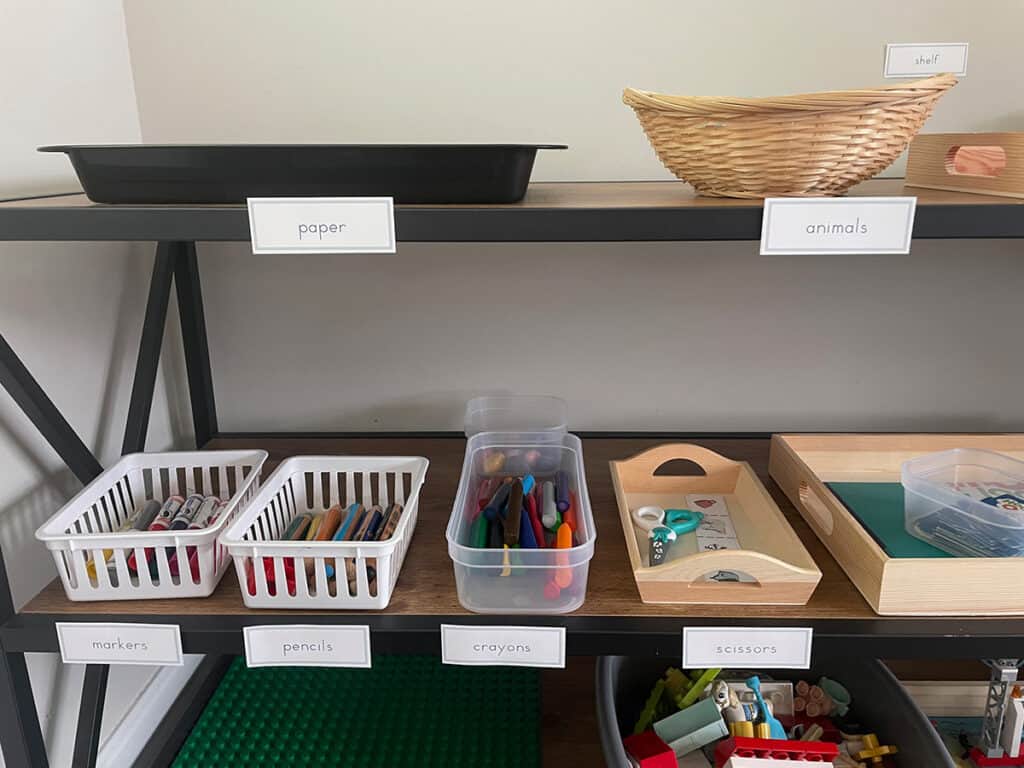
We placed a label for all of the art supplies on the shelf. I placed them on the shelf with Annie and I named them as I placed them.
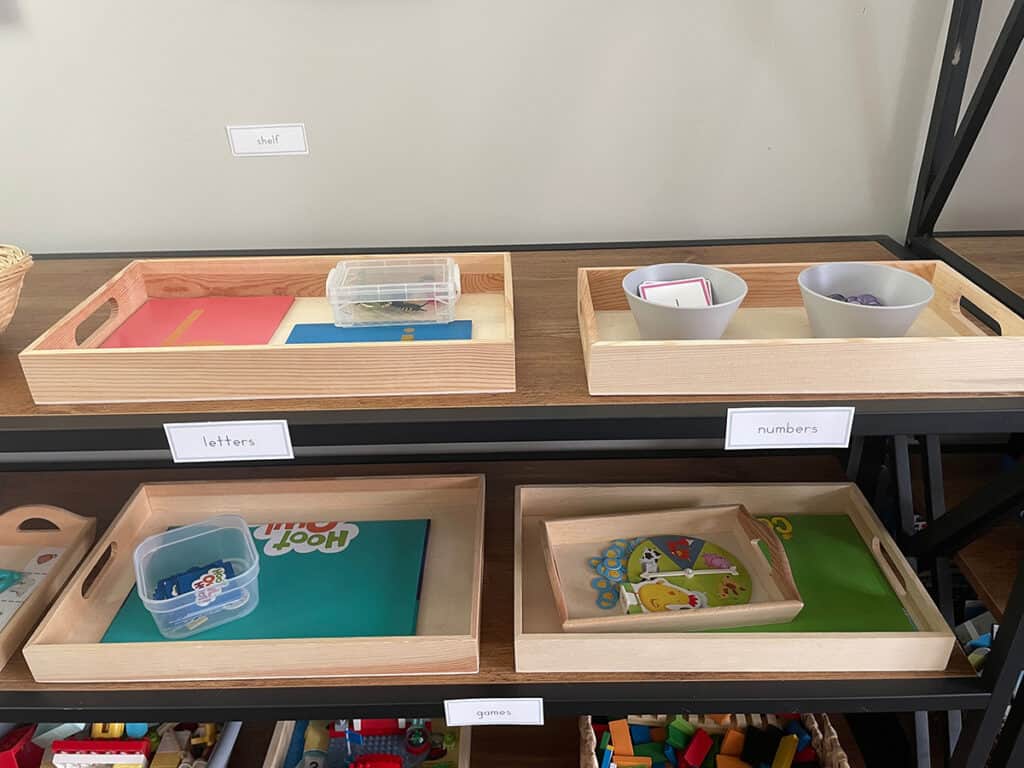
We included a label for the letters we’re currently working on as well as a label for a number counting work.
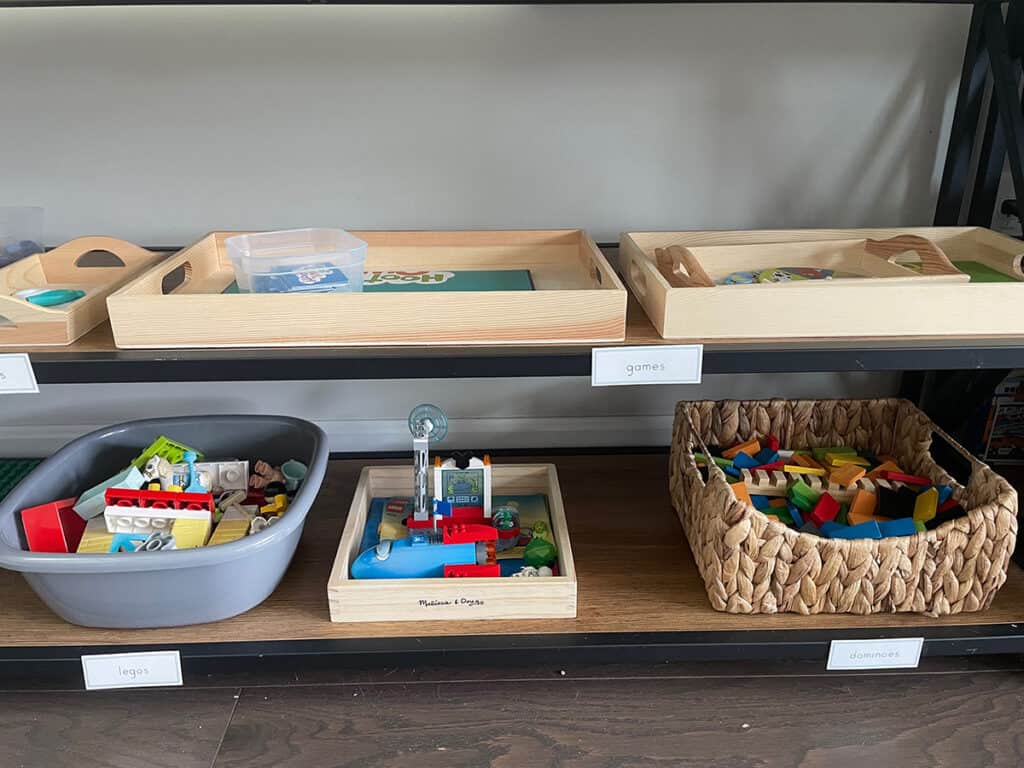
Annie is really into games, building things and puzzles, and there’s always a collection of her favorites on the shelf. We placed a label for games, legos and dominoes. There’s also one for puzzles, but it’s not shown in the picture here.
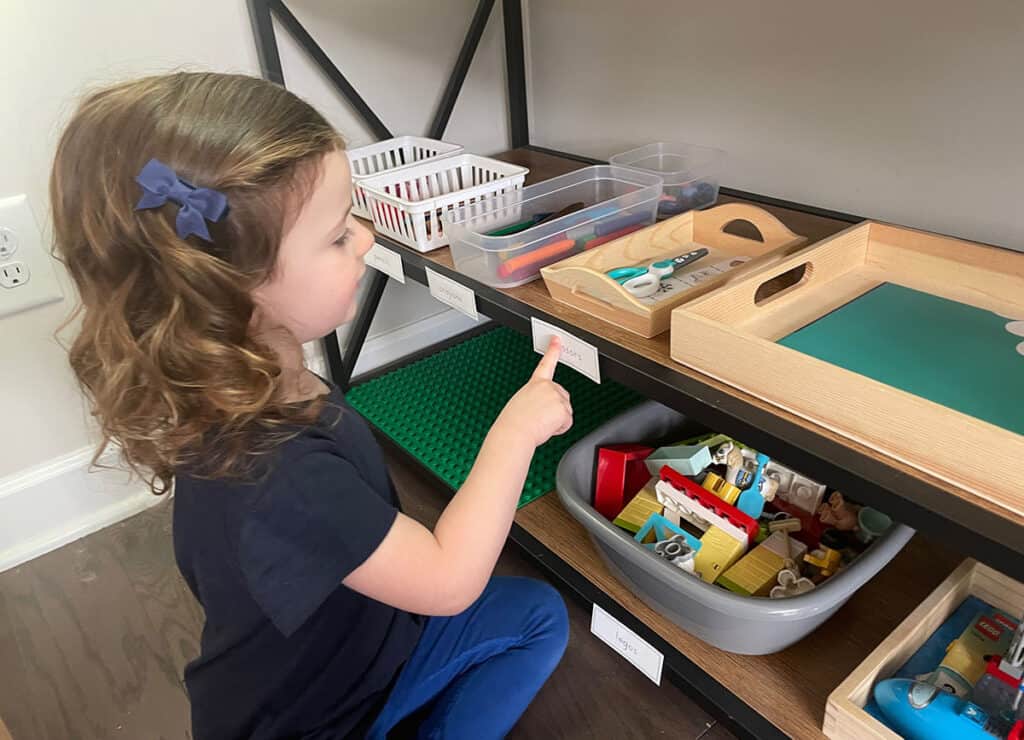
After we placed all of the signs, I noticed that Annie was more interested and curious about the activities she had on her shelf. Everything seemed to look new and different with a sign under each tray.
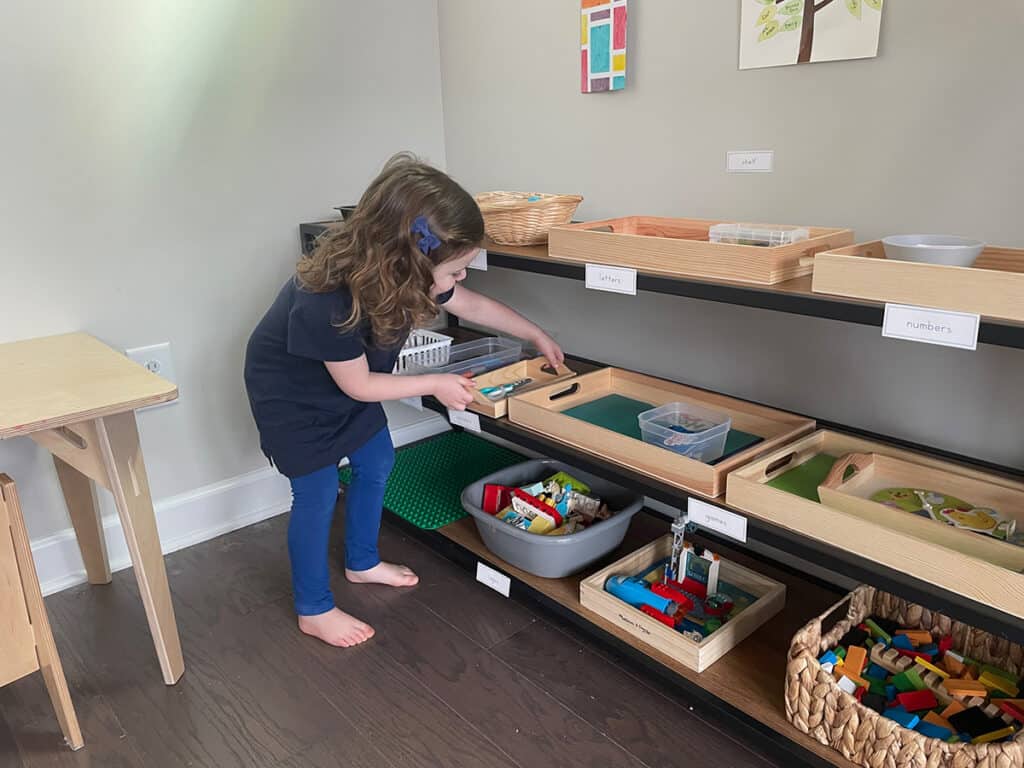
She had fun exploring her “new” shelf and finally decided on what she wanted to work on next. She chose the scissor tray to cut paper strips!
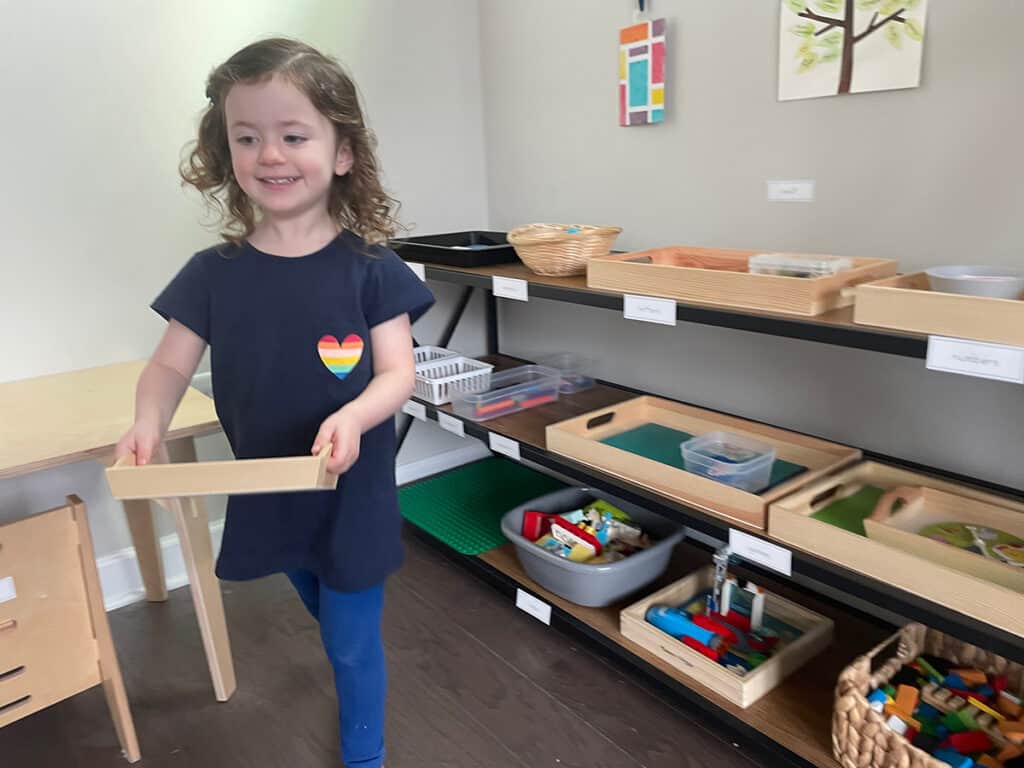
When Annie completed her work, I noticed that she was more willing to put the tray back where it belonged, in the correct spot by its sign.
Normally, she would leave her tray out, forgetting to put it away or she would put it in the wrong spot. So another benefit is that the labels helped her with putting her work away.
Could we add a picture to each sign?
You may be asking yourself, could we add a picture to each sign? After all, the first example I gave in the beginning of this post was about a snack sign I made with a simple sketch of graham crackers and raisins!
Yes, of course you can add a picture to your signs. Often, you’ll see in toddler and preschool classrooms print signs with a photo, icon, or simple sketch of what the sign says.
This is optional and your child will get the same benefit of print awareness and early literacy development. For the littlest children, it will help them to find what they’re looking for more independently.
But, I find that having a text-only sign to match an object works just as well. Amazingly, young children will be able to make the connection between the letters on a label and what it goes with fairly quickly, even if they’re not reading or decoding yet.
The children seem to accept it and understand it. And over time, text-only signs can help bring additional awareness to the actual print letters words.
It’s totally optional and it’s up to you, if you’d like to add pictures to your labels or signs!
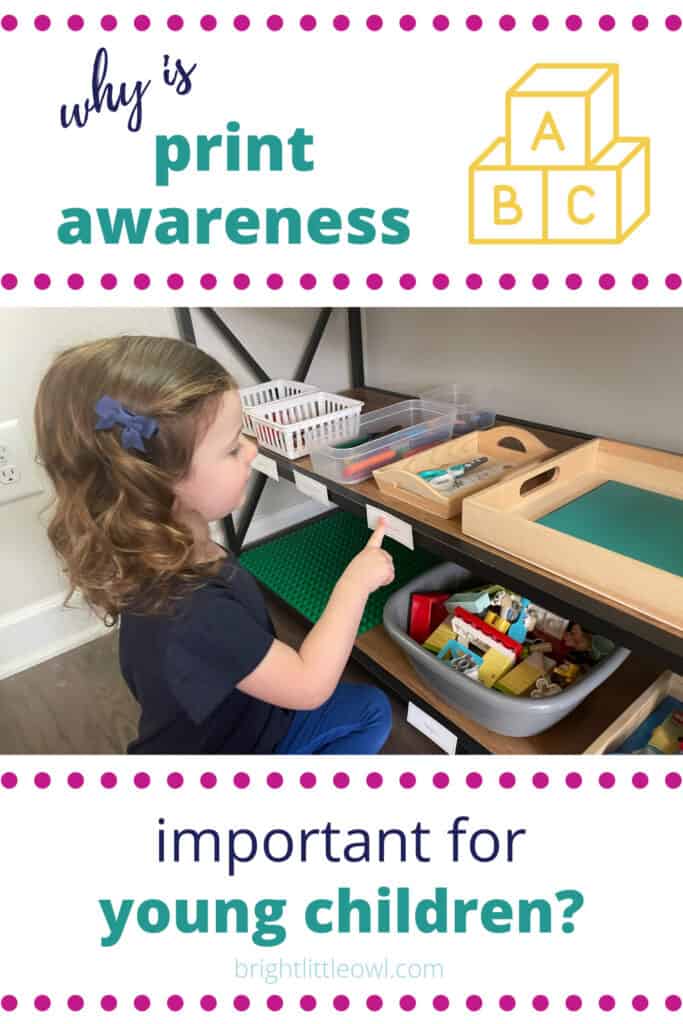
Concluding thoughts about signs for print awareness
We had a lot of fun with the naming game. Annie especially loved the missing object game. After doing this a few times she would randomly get the mat and pick three objects, asking me to come to the living room floor to play the “what’s missing game.”
She’s also starting to point out the labels and say “those are signs!” She already knows where all the clothes are in her dresser drawers, so she points to the sign and says “the pajamas are in here.”
I know that this is developing language even though she is not reading or decoding yet.
Have you ever made signs or labeled items in your child’s room? Did you also have pictures on the signs? How did it work out? If you downloaded the 140 labels I made for you and tried them, let me know how it went. Leave a comment below!
More Montessori Resources
You can also download the lesson plans for:
Lesson 1: Beginning Oral Language Activities
Lesson 2: Picture Story (Dictation) Plus 24 photos and the lined paper we used!
Lesson 3: Naming – plus 140 labels for around the house
Lesson 4: Classified Objects – plus 8 insect photo cards
Lesson 5: Object Discrimination (Object Matching)
I will be adding all of the lesson plans as I write additional blog posts about Oral Language.
You can download them all below, by signing up for the Resources Library.
Stick labels around the house for print awareness
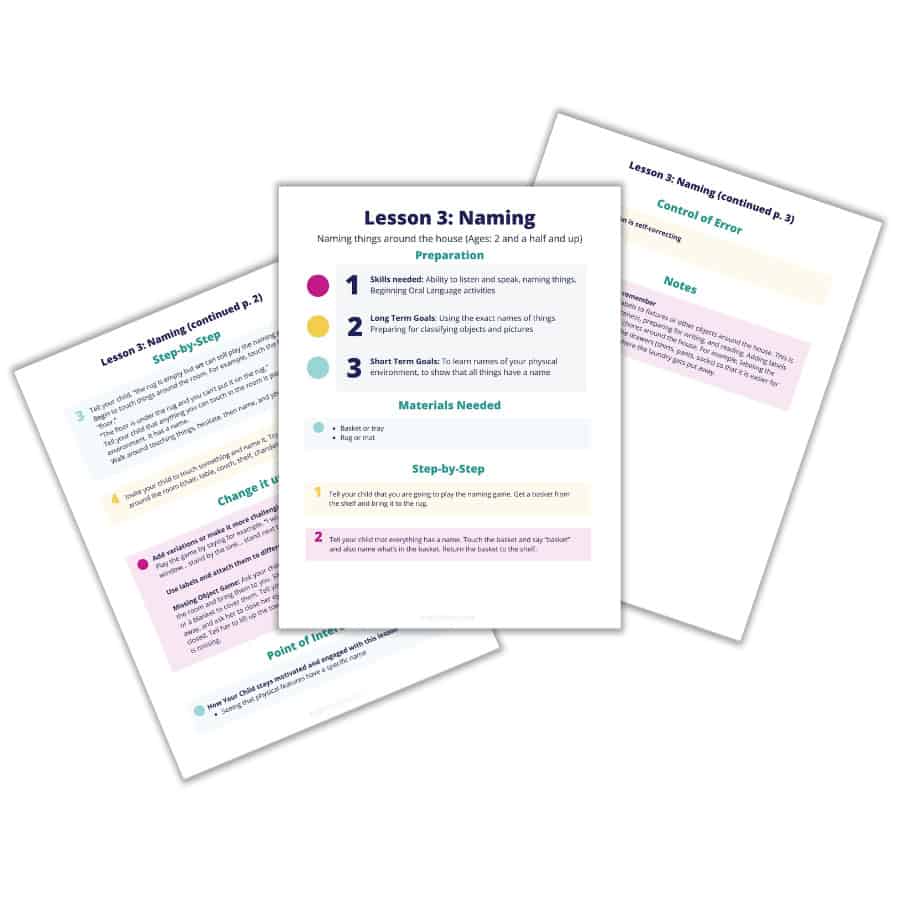
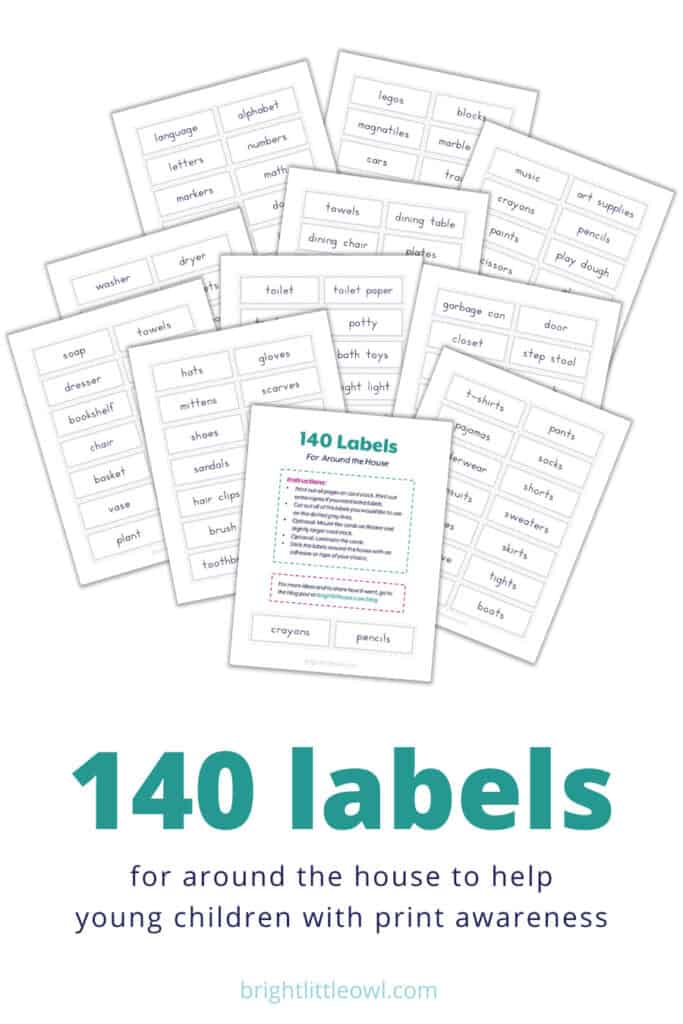

This is a great idea. I have labels around the home for things, but not to the extent of what you have shown. I think it teaches the sight word along with spelling.
Loving these ideas of littles.
Such a great idea! What a creative way to help children learn.
This has so many great resources! Thanks for sharing!
I love the fact that labelling things around the house, besides keeping everything organised, also helps kids with early reading.
You hear about this a lot for learning a second language, but it’s a great idea for learning the first as well! Never thought about it! My twins are 6 so this could be great for them!
I never knew labeling stuff in the house has so much benefit to give to our kids apart from making things organised. Glad to have come across with this post.
Thanks for sharing. I have notecards every where for this purpose.
I love labeling things so this was something I did with my kids when they were little. It was so fun to watch them learn different words.
I love this idea of putting label on common things around the house. My toddler is starting to recognize words and loves reading out loud. It amazes me how quickly he can associate set of letters to a word.
What a great way to get kids learning the most necessary words for daily living. Such a wonderful idea!
Love this idea and I think we will be trying this at home! The bigger kids will get it right away and it will be a great learning tool for the smaller ones (:
Very innovative! Thanks for sharing.
This is such a great activity and it also makes my anxiety so much lower! I love having everything labeled, but I didn’t know it could be so beneficial for my daughter too.